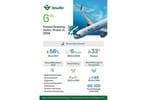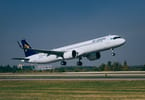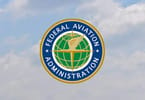According to a recent study, nearly half of US airport executives are concerned about their financial stability, even though there has been an increase in air travel. The recovery after the pandemic has shown variations across regions, with around 37% of airport leaders reporting persistent levels of debt, which highlights an uneven economic rebound.
Based on a global study involving 200 airport leaders, findings from a thorough survey of 100 US airport leaders reveal that 51% of US airports have not yet regained their pre-pandemic revenue levels. To address this issue and promote growth, US airport leaders are focusing on two key initiatives: enhancing growth margins (93%) and optimizing and expanding capacity for take-off and landing slots (95%), in order to take advantage of the current increase in air travel demand.
However, American air hubs face numerous obstacles in achieving this growth:
Staffing problems: Currently, approximately 45% of airports in the گڏيل رياستون are facing staffing shortages due to the ongoing surge in air travel. These shortages are a direct result of the growing demands of flights and passengers. What is even more alarming is that 61% of airport leaders consider this staffing issue to be a major risk that will impact their operations in the next year.
Capacity limits: Insufficient terminal space hampers over one-quarter (26%) of US airports, limiting their capacity to accommodate additional airlines and posing a risk to their expansion and growth.
Flat customer spending: Due to the ongoing cost-of-living crisis, US airport leaders who had prioritized consumer spending as their primary revenue driver now expect a negative impact on passenger spending with concession partners and essential ancillary revenues, with 67% expressing this anticipation.
Disruptions and flight cancellations: Airport leaders are expressing worry about the consequences of uncontrollable disruptive events, such as delayed flights, air traffic issues, or severe weather. A significant concern is the impact these disruptions can have on their reputation with passengers, with 71% expressing fear and 75% highlighting the potential negative effects of flight cancellations.
Despite a generally strong US aviation outlook, many airports are facing difficulties in keeping up with the increasing demand from passengers. While the majority of US airports recognize the significance of obtaining federal funding, such as through the Biden Infrastructure Bill, to support long-term growth as a top commercial priority, they are currently dealing with immediate concerns related to staff shortages and limited terminal capacity. Currently, airport leaders are focusing on exploring strategies to improve their operations and make the most of their existing capacity, with the aim of accommodating more airlines and passengers and ultimately boosting their revenue.
Airport executives have identified four key areas in which they perceive potential for enhancing their growth:
Attracting new carriers: To increase flight numbers and capacity, US airports aim to attract new airlines (93%) and optimize take-off and landing slots (95%). To achieve this, airports plan to improve gate management, provide airlines with operational data, and reduce costs through shared check-in desks. This is in response to 50% of US airports still needing to fully restore pre-pandemic routes.
Improve flyer experiences: US airports prioritize enhancing passenger experiences to attract more travelers, as evidenced by their recognition of the importance of achieving favorable rankings for passenger satisfaction, like those given by Skytraxx (92%). To achieve this goal, they are dedicated to minimizing security wait times, providing a seamless airport experience, and implementing additional self-service options for check-in and baggage drop-off.
Boost traveler spending: US airports have set a goal to boost revenue by increasing passenger spending, with 90% of them actively working towards this. They plan to achieve this by transforming airports into attractive shopping destinations, providing a wide array of retail options, and streamlining check-in and security procedures to allow passengers more time to explore the concession areas for pre-planned purchases.
Upgrade airport operations: Improving airport operations is a key focus for 92% of US airport leaders, who prioritize upgrading outdated technologies and systems. This effort aims to enhance operational efficiency and effectively handle unforeseen disruptions. Interestingly, 60% of these leaders perceive the decision to avoid investing in new technologies such as SaaS platforms, automation, and AI as a major risk to optimizing airport operations in the next year.
Legacy systems and technologies continue to be relied upon by numerous airports in the US, reflecting a global trend. This reliance hampers their efficiency in managing existing assets and attracting new airlines, which is crucial for capitalizing on the growing demand for air travel.
Surprisingly, 43% of US airport leaders still resort to using Excel and Word documents to store and manage operational information, including gate management and RONs (Remain Overnights). This dependence on manual processes and outdated systems presents significant obstacles to revenue growth. To secure future growth, airports must embrace the advantages offered by artificial intelligence, computer vision, and the cloud.























